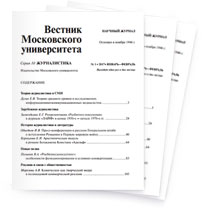Issue
Content:
-
Media Economics
«A New Tool for Measuring Concentration in the Media Industry (The First Approbation of a Theoretical Development)»
The paper presents the historical background, theoretical underpinning and methodology of creating a new tool for measuring concentration in the media industry. Conceptually, the development of SMCI (the Synergetic Media Concentration Index) appears to be an extension of the idea realized by MOCDI (the Media Ownership Concentration and Diversity Index). The first results of calculating the new index in an assessment of the market environment in the Russian media industry are provided. As a starting object of measurement, the author selected federal television, the largest and most transparent segment.
Keywords: media industry, segment, concentration, index, revenues, audience, number of media outletsSergey S. Smirnov 3 -
Television and Radio
«Operation of Regional Television in Russia and France: A Case Study of Television Companies in the Krasnodar Territory and the Provence Region»
The article examines Russian and French regional television in two selected regions (the Krasnodar territory and Provence) in a case study of five regional TV channels. The author conducted a comparative analysis of the structure and content of these channels. The analysis of the structure revealed considerable differences: in the Russian region selected for the study there are no private terrestrial channels, which is characteristic of most Russian regional media systems; moreover, France has a special regional broadcasting TV channel (France 3). However, the analysis of the broadcast schedule of the channels and content analysis of news broadcasts highlighted some common features of the television systems: the presence of full broadcast channels, similar broadcast programming, the decentralization of news and similar issues of news content.
Keywords: regional television, local television, regional television companies, content analysis, Russia, FranceAnastasia N. Ivanova 18 -
«Ethnic Audiovisual Mass Media of Tatarstan as Part of the Republic’s Media Landscape: A Quantitative and Typological Analysis»
The article analyzes ethnic audiovisual mass media of the Republic of Tatarstan. By ethnic mass media the author means those which broadcast in the Tatar language or are bilingual. The focus is on the radio stations and television channels which broadcast from the city of Kazan and are registered there. The author examines their ownership structure and their thematic orientation, attempts to define the role of these mass media in the media system of the Republic of Tatartstan.
Keywords: media system of Tatarstan, ethnic mass media, mass media in the languages of the peoples of Russia, audiovisual mass media, media as a tool for consolidating ethnic groupsDiana Yu. Kulchitskaya 40 -
New Media
«Creating the Image of China on the CGTN Page on Facebook: Results of a Content Analysis»
The article analyzes the state of the CGTN company’s media activity on the Facebook social network as well as the strategies and problems of this activity. Particular attention is drawn to the strategy of promoting content for the Englishspeaking audience as part of China’s “soft power”. The article describes the factors that impede media development abroad, although within the short time of broadcasting to English-speaking countries the Chinese media have already developed their own identity in external communication.
Keywords: China, English-speaking audience, international broadcasting, Facebook, CGTN, “softpower”Yin Ruyu 51 -
Theory of Journalism and Media
«The Use of Frequency Analysis of Media Texts to Optimize the Communication Process»
Media texts pass through the channels of mass communication. When the potential information contained in the texts reaches the consumer (the audience) it becomes inputted information. The effectiveness of this process largely depends on the degree to which the texts have the qualities that allow for an optimal passage through the channels of mass communication and a successful conversion of information in the communication process. In order to make adjustments to the texts and increase the efficiency of their use, one can benefit from the programs of text frequency analysis available on the Internet. These programs make it possible, as long as automatic frequency analyzers are applied, to promptly obtain information about the structure, linguistic features, accessibility for the audience and other qualities of the texts, to optimize the communication process.
Keywords: media texts, communication channels, communication process, optimization, frequency analysisTatiana V. Shumilina 67 -
History of Journalism
«Birzhevye Vedomosti Edited by K.V. Trubnikov: A Brief Essay of the Newspaper’s Publication (A Study of Censorship Materials)»
The paper examines the history of the Russian stock exchange newspaper Birzhevye Vedomosti edited by K.V. Trubnikov in a case study of materials of the Russian State Historical Archive. The Archive houses more than ten records related to the history of stock exchange newspapers, in particular the newspaper under consideration. This allows to reconstruct its history from 1860 to 1878 in a documented form and correct the inaccuracies in scientific and reference literature.
Keywords: Birzhevye Vedomosti, Birzhevaya Gazeta, Vechernyaya Gazeta, publishers, editors, K.V. Trubnikov, censorship,program.Boris I. Esin 80







